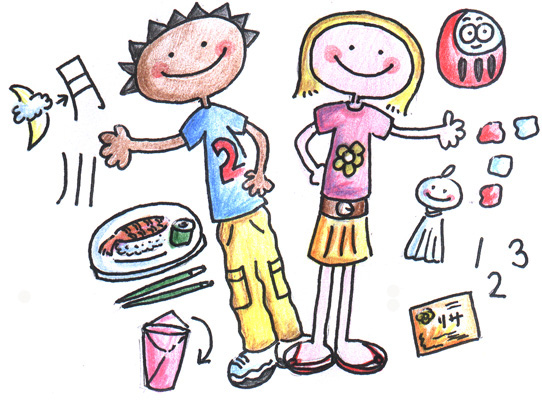Lesson 7
Culture notes Download pdf
Although Japanese people eat lots of Western food, such as pizza, spaghetti and hamburgers, they also have many Japanese dishes. Here are a few of the most famous dishes in Japan:
Food
Tempura
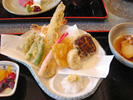 Tempura originally came to Japan from Portugal during
the sixteenth century. The Japanese have since adapted
it to suit their taste buds. Tempura consists of lightly
battered vegetables, fish or shell fish. After frying, they
are dipped in a special dipping sauce before eating. The
sauce contains grated daikon radish which is said to cut
through the oiliness of the deep-fried food.
Tempura originally came to Japan from Portugal during
the sixteenth century. The Japanese have since adapted
it to suit their taste buds. Tempura consists of lightly
battered vegetables, fish or shell fish. After frying, they
are dipped in a special dipping sauce before eating. The
sauce contains grated daikon radish which is said to cut
through the oiliness of the deep-fried food.
Q: What do British people normally sprinkle on their fish and chips to help cut through the oiliness of the batter? Can you name any foreign foods which have entered the British diet? What might the reason for this be?
Okonomiyaki
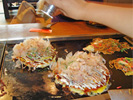 These savoury pancakes are extremely popular in
Japan and there are many restaurants where you
can cook your own over a hot griddle. The pancake
dough is made of flour, water and eggs and the main
dry ingredients are white cabbage, mushrooms and
some kind of meat or fish (usually pork, chicken or
prawns). A savoury sauce (a bit like brown sauce) and
mayonnaise are squirted on the top of the pancake
and topped off with shredded seaweed pieces and
dried fish flakes. Sometimes you may eat okonomiyaki with noodles in them or a
fried egg on top - there are many regional variations.
These savoury pancakes are extremely popular in
Japan and there are many restaurants where you
can cook your own over a hot griddle. The pancake
dough is made of flour, water and eggs and the main
dry ingredients are white cabbage, mushrooms and
some kind of meat or fish (usually pork, chicken or
prawns). A savoury sauce (a bit like brown sauce) and
mayonnaise are squirted on the top of the pancake
and topped off with shredded seaweed pieces and
dried fish flakes. Sometimes you may eat okonomiyaki with noodles in them or a
fried egg on top - there are many regional variations.
Q: Are there any famous local foods where you live? If you were making your own ‘regional style okonomiyaki’, what local produce might you put on your pancake?
Soba Noodles
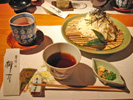 Soba are noodles made from buckwheat and ordinary
wheat. They are extremely long and thin and are usually
a grey colour. They can be eaten hot or cold and are
served with a fish based dipping sauce, or in a soup.
They are often topped with seaweed and/ or spring
onions. One of the most popular variations of soba is
called cha-soba and the noodles appear a greenish
colour as green tea is used in their preparation.
Soba are noodles made from buckwheat and ordinary
wheat. They are extremely long and thin and are usually
a grey colour. They can be eaten hot or cold and are
served with a fish based dipping sauce, or in a soup.
They are often topped with seaweed and/ or spring
onions. One of the most popular variations of soba is
called cha-soba and the noodles appear a greenish
colour as green tea is used in their preparation.
Q: Have you ever eaten noodles? What did they taste like? What did you eat them with? Do you know what udon noodles are? Use the internet and books to research. How are they different to soba noodles? What about ramen noodles? (The popular fast food cup noodles are based on ramen).
Note: There is even a cup noodle museum in Yokohama! (http://www.raumen.co.jp/english/)
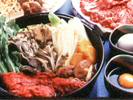
Sukiyaki ー a Japanese broth
Thin strips of beef, vegetables, noodles and cubes
of tofu are cooked in a sauce and dipped in beaten
raw egg to cool it slightly before eating. This meal is
cooked at the table and people help themselves to
their favourite ingredients.
Senbei
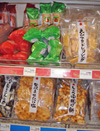 Senbei are Japanese rice crackers and are eaten as a snack
(often accompanied with a drink of green tea). There are many
different varieties – some are grilled, some are fried, but many of
them will be flavoured with soy sauce. Some senbei also come
wrapped in seaweed, whilst others may have dried shrimp in
them. There are often regional specialities of senbei and people
will travel long distances to taste them. Niigata prefecture is
particularly famed for its delicious rice cracker flavours.
Senbei are Japanese rice crackers and are eaten as a snack
(often accompanied with a drink of green tea). There are many
different varieties – some are grilled, some are fried, but many of
them will be flavoured with soy sauce. Some senbei also come
wrapped in seaweed, whilst others may have dried shrimp in
them. There are often regional specialities of senbei and people
will travel long distances to taste them. Niigata prefecture is
particularly famed for its delicious rice cracker flavours.
Q: What sort of crackers are popular in the UK? What are your favourite crackers? What are crackers in the UK made from? Can you buy rice crackers in Britain?
Sweets
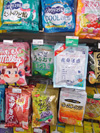 Alongside the traditional Japanese style sweets (wagashi),
most Japanese children also like Western style candy
– whether it be chocolate or boiled sweets. In the picture
on the right, you can see various examples of boiled sweets
including sweet red bean flavour! The girl with the red cheeks
on the middle left packet of sweets is known as Pekochan – she
is a popular mascot with many products such as pens, pencils,
even lunchboxes featuring her face! For more information,
visit: https://www.fujiya-peko.co.jp/ (Japanese)
Alongside the traditional Japanese style sweets (wagashi),
most Japanese children also like Western style candy
– whether it be chocolate or boiled sweets. In the picture
on the right, you can see various examples of boiled sweets
including sweet red bean flavour! The girl with the red cheeks
on the middle left packet of sweets is known as Pekochan – she
is a popular mascot with many products such as pens, pencils,
even lunchboxes featuring her face! For more information,
visit: https://www.fujiya-peko.co.jp/ (Japanese)
Q: What are traditional Japanese sweets made from? What are popular fillings in traditional Japanese sweets – use books and the internet to find out.
https://web-japan.org/kidsweb/cook/wagashi/index.html
https://web-japan.org/kidsweb/cool/20/202011_japanese-candy_en.html
Rice burger
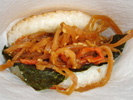 Rice burgers are sold in Mos Burger, a Japanese hamburger
chain. The bun is made of grilled rice and the filling is
called kinpira – a spicy mix of root vegetables, sesame
seeds and seaweed. Other Japanese style burgers sold
in the chain include the deep-fried prawn and cabbage
burger and the teriyaki chicken burger. More information
on Mos Burger can be found on their website here:
https://www.mos.jp/menu/ (Japanese) or in the Culture Notes in Lesson 8.
Rice burgers are sold in Mos Burger, a Japanese hamburger
chain. The bun is made of grilled rice and the filling is
called kinpira – a spicy mix of root vegetables, sesame
seeds and seaweed. Other Japanese style burgers sold
in the chain include the deep-fried prawn and cabbage
burger and the teriyaki chicken burger. More information
on Mos Burger can be found on their website here:
https://www.mos.jp/menu/ (Japanese) or in the Culture Notes in Lesson 8.
Q: Are there any items on UK fast food menus that are British? If so, what are they?
Are there any other items chains in Japan that are unusual? What are they? Use
the internet to look some of the fast food restaurants in Japan:
McDonalds - https://www.mcdonalds.co.jp/menu/ (Japanese)
KFC - https://www.kfc.co.jp/menu/index.html/ (Japanese)
Vegetables
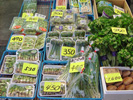 Many of the vegetables shown on this stand are typically Japanese
and are not commonly found in the UK – they include vegetables
such as honeywort, oil seed rape, shiitake mushrooms, hajikami (a
type of ginger), taro potatos and a type of bracken called zenmai.
Many of the vegetables shown on this stand are typically Japanese
and are not commonly found in the UK – they include vegetables
such as honeywort, oil seed rape, shiitake mushrooms, hajikami (a
type of ginger), taro potatos and a type of bracken called zenmai.
Q: Are there any vegetables that the children do recognise?
Onigiri
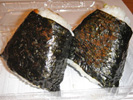 Onigiri are Japanese rice balls – the most
common type of onigiri is a triangular shaped ball
of rice, wrapped in seaweed with a filling in the
middle (usually fish, such as tuna or salmon,
although pickled plum is also popular). Onigiri
make for popular lunchtime snacks as they are
filling and nutritious. Japanese children will
usually take onigiri with them on school trips,
either homemade or shop bought.
Onigiri are Japanese rice balls – the most
common type of onigiri is a triangular shaped ball
of rice, wrapped in seaweed with a filling in the
middle (usually fish, such as tuna or salmon,
although pickled plum is also popular). Onigiri
make for popular lunchtime snacks as they are
filling and nutritious. Japanese children will
usually take onigiri with them on school trips,
either homemade or shop bought.
Q: What might you have for school lunch instead of an onigiri? Which do you think is the more healthy? Why? If you were to design your own onigiri, what would you have as the filling? Think carefully about whether it would go with rice.
Miso Soup
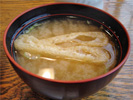 Miso soup is an important part of the Japanese diet. It is eaten
at most meals (including breakfast) as an accompaniment to the
main dish. The soup is made from miso paste (fermented soya
beans with malted rice and salt), dashi fish stock and various
other ingredients including seaweed, spring onions and tofu.
The soup is served in a small bowl and is drunk directly from it –
no spoon is used. Chopsticks are used to hold food in the soup out of the way while
drinking the broth and are also used to pick out food from the bowl as well.
Note: Japanese people ‘drink’ soup, they don’t eat it:
Miso soup is an important part of the Japanese diet. It is eaten
at most meals (including breakfast) as an accompaniment to the
main dish. The soup is made from miso paste (fermented soya
beans with malted rice and salt), dashi fish stock and various
other ingredients including seaweed, spring onions and tofu.
The soup is served in a small bowl and is drunk directly from it –
no spoon is used. Chopsticks are used to hold food in the soup out of the way while
drinking the broth and are also used to pick out food from the bowl as well.
Note: Japanese people ‘drink’ soup, they don’t eat it:
miso shiru o nomimasu味噌汁を飲みます
Drink
Green Tea
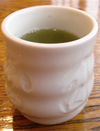
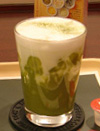
Sencha is perhaps the most common of the green teas – it is made from steamed and dried tea leaves. Matcha is made from new green leaves which are ground down into a fine powder. This type of tea is used in the tea ceremony. Matcha latte is a new trend and a popular iced beverage in the summer and matcha is mixed with cream, ice and milk. Bancha is made from the hard leaves and stalks after the young and soft leaves have been picked for the sencha.
Q: Can you think of any other hot drinks which are said to be good for your health? What are they and what properties do they contain?
Kakikori – frozen ice drink
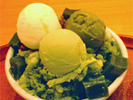 Kakikori is a refreshing drink, enjoyed by many on a hot
summer’s day. It is made from crushed ice and usually has
a fruity syrup poured over the top. Many snack stalls sell
these drinks during the summer festivals held in towns
all across Japan. They advertise the drink by using a small
flag with the character for ‘ice’ written on it. There are also
various other varieties of kakikori, some including sweet
red beans and rice ball flavours. The one here has green
tea flavouring, green tea jelly and green tea ice cream on
the top. Note that Japanese people ‘eat’ kakikori, they
don’t drink it.
Kakikori is a refreshing drink, enjoyed by many on a hot
summer’s day. It is made from crushed ice and usually has
a fruity syrup poured over the top. Many snack stalls sell
these drinks during the summer festivals held in towns
all across Japan. They advertise the drink by using a small
flag with the character for ‘ice’ written on it. There are also
various other varieties of kakikori, some including sweet
red beans and rice ball flavours. The one here has green
tea flavouring, green tea jelly and green tea ice cream on
the top. Note that Japanese people ‘eat’ kakikori, they
don’t drink it.
Q: Can you think of any similar drinks which are enjoyed in Britain on a hot summer’s day?
Pokari Sweat
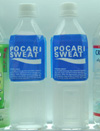 Pokari Sweat is a sweet, isotonic Japanese drink which is said to be
good for you. It is made up of various minerals and ions which are
thought to help your body remain healthy and they replace all of
the properties you lose when going to the loo, or when you sweat!
For more information on Pocari sweat, check out: https://www.
otsuka.co.jp/en/nutraceutical/products/pocarisweat/
Pokari Sweat is a sweet, isotonic Japanese drink which is said to be
good for you. It is made up of various minerals and ions which are
thought to help your body remain healthy and they replace all of
the properties you lose when going to the loo, or when you sweat!
For more information on Pocari sweat, check out: https://www.
otsuka.co.jp/en/nutraceutical/products/pocarisweat/
Q: Pokari Sweat is quite an odd name for a drink – why do you think the name might have to change if it was sold in the UK? If you had to make up a new name for the product, what would you call it? Why?

Melon Soda Float
Melon soda is a popular drink, especially amongst children, and
can be found in many fast food chains throughout Japan. As
with a coke float, a scoop of ice cream is added to the melon
flavoured soda and allowed to froth up. It is then eaten with a
long spoon and the remaining juice drunk through a straw!
Jidohanbaiki – vending machines
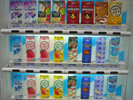 Drinks vending machines can be found on virtually every
street corner in Japan and they sell a wide range of
beverages, from cartons to cans to hot and cold drinks. You
can even buy beer from street vending machines! The
general cost of a drink from a vending machine is 120 yen.
In the picture here, you can see various fruit juices and
coffee drinks.
Drinks vending machines can be found on virtually every
street corner in Japan and they sell a wide range of
beverages, from cartons to cans to hot and cold drinks. You
can even buy beer from street vending machines! The
general cost of a drink from a vending machine is 120 yen.
In the picture here, you can see various fruit juices and
coffee drinks.
Q: What sort of drinks can you buy in British vending machines? Why don’t you think there are many vending machines on the streets? Why do you think beer wouldn’t be sold in a vending machine here?
Calpis
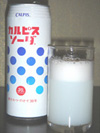 Calpis is the name of a Japanese drink. It is made by adding
bacteria to non-fat milk and then fermenting the two together.
Special cultures are then added and the process repeated.
The resulting colour is off white and the drink has a distinctive
sweet and sour taste.
Calpis is the name of a Japanese drink. It is made by adding
bacteria to non-fat milk and then fermenting the two together.
Special cultures are then added and the process repeated.
The resulting colour is off white and the drink has a distinctive
sweet and sour taste.
Q: Can you think of any drinks in the UK which are said to be good for your health? What are they?
